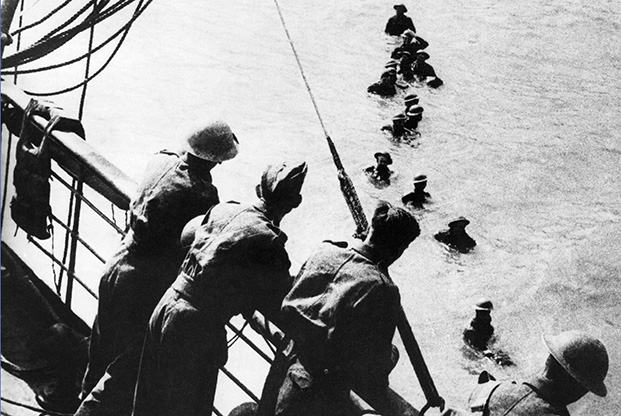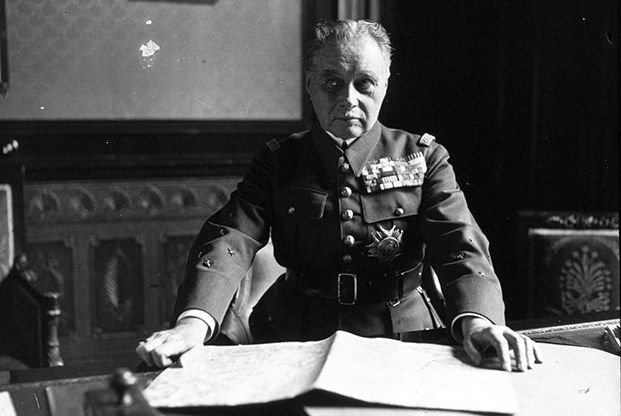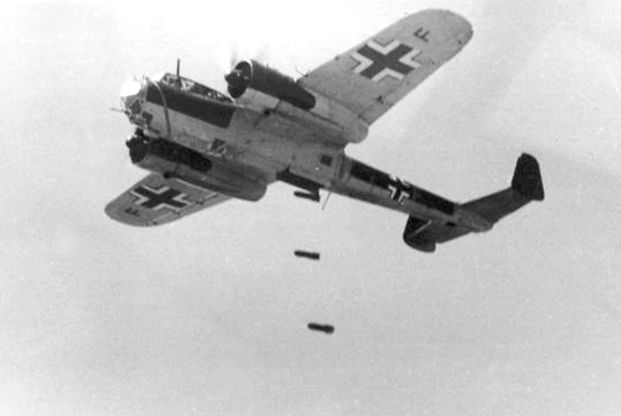
British soldiers wade from the beaches at Dunkirk to a waiting destroyer during a massive evacuation effort just before the fall of France. Photo: Imperial War Museum
As war clouds gathered over Europe in the summer of 1939, the French were boldly confident of their capability to defend themselves should Germany be rash enough to attack.
“The French Army is stronger than ever before in its history,” declared Gen. Maxime Weygand, the retired chief of staff. “Its equipment is the best, its fortifications are first rate, its morale is excellent, and it has an outstanding high command. Nobody wants war but if we are forced to win a new victory then we will win it.”
The military editor of The New York Times, Hanson W. Baldwin, was of a similar opinion. “The French army has long been called by experts the ‘best in the world,’ and its finest divisions undoubtedly are unmatched,” he said.
The French were ahead of the Germans, or nearly so, in almost every category of military power. They had more tanks, more artillery, more men under arms, and about the same number of combat airplanes.
The entire French-German border, from Basel in Switzerland to the Longwy on the Luxembourg frontier, was protected by the Maginot Line, a continuous string of linked concrete fortifications, mine fields, barriers, ditches, and prepared fields of fire.
With reduced requirement for mobile forces on that front, the French could allocate more of their manpower to the Belgian border on the north, where a German attack, if there was one, was expected to come. The lowest priority for defense were the approaches from the Ardennes Forest—regarded as “impenetrable”—between the Maginot Line and Belgium.
The Germans invaded Poland Sept. 1, 1939, and two days later, Britain and France declared war. The French did not redeploy their forces based in North Africa and other colonial territories, but the numbers added by the Belgians and Dutch—previously declared neutral—and the British Expeditionary Force, ensured a favorable ratio. On the Western Front, 151 Allied divisions faced 135 German divisions in the spring of 1940.
French confidence gave way to cockiness. Gen. Maurice Gustave Gamelin, 68, the current army chief and commander of the armed forces, said in February 1940 that he would be happy to make the Germans a gift of one billion francs if they would do him the favor of taking the initiative in an attack.
What followed ranks as one of the most stunning upsets in the history of warfare. The Germans invaded western Europe May 10, 1940, and with a success that surprised even themselves, completely routed the French and their allies in less than six weeks. On June 22, the French signed a humiliating armistice that marked the end of their independence as a nation.
How could it have happened?

A German light bomber drops bombs over France in June 1940. The French had more combat aircraft than Germany, but only a fourth were operational on the Western Front. Photo: German Federal Archives
SHIFT TO THE DEFENSIVE
After World War I, the French military abandoned its traditional offensive doctrine for a defensive strategy called bataille conduit, or “methodical battle.”“The ‘methodical battle’ started from the premise that in modern warfare the strength of firepower bestowed an immense advantage upon the defender,” said historian Julian Jackson. “Massing the amount of material necessary to carry out a successful offensive was a complex logistics operation that required meticulous preparation.
“What the army wanted to avoid above all were improvised ‘encounter’ battles where moving armies came upon each other without having prepared their positions. Instead, the emphasis of French doctrine was on a tightly controlled battle where decision-making was centralized at the highest levels. This was in stark contrast to German doctrine, which encouraged initiatives by lower-level commanders.”
The Maginot Line, built between 1930 and 1937, was a key aspect of the strategy, blocking an advance from the east and establishing a stable front on the French-German border.
The expectation was that, if the Germans did attack, they would come charging through Belgium, as they had done in the “Schlieffen Plan” that opened World War I in 1914.
The bedrock assumption was that France would meet the German attack in Belgium. A basic problem with that was the weakness of the Benelux countries. Luxembourg had only a few hundred soldiers and a 12-horse cavalry troop. The armies of Belgium and the Netherlands, with respective strengths of 650,000 and 400,000, were substantial, and the Belgians had 270 tanks.
In 1936, however, King Leopold of Belgium repudiated the military treaty with France and declared neutrality. The Dutch followed his example, and French forces were denied entry. Unknown to Leopold, the French planned to go into Belgium anyway if they needed to, although prepositioning was not possible.Leopold did not change his mind until the invasion. A few hours after the Germans crossed his border, he asked the French for help.

A column of German Panzers move through a French town in May 1940. Photo: Erhardt Eckert/German Federal ArchivesSICKLE CUT
The French had not been altogether wrong about German strategy. “Indeed, in the first three drafts of the German campaign plan, drafted between October 1939 and January 1940, the primary attack was against Belgium by the right wing of the German army,” said Karl-Heinz Frieser, a German historian.Germany had assembled three army groups on the Western Front: Group B in the north opposite Holland and Belgium, Group A in the center facing the Ardennes, and Group C in a holding action against the Maginot Line in the south.
Lt. Gen. Heinz Guderian, Germany’s best tank officer, convinced Gen. Erich von Manstein, chief of staff of Army Group A, that he could move his panzers efficiently through the Ardennes and Manstein convinced Hitler. The primary attack would be delivered by Group A under Gen. Gerd von Rundstedt.
“The new plan was a mirror image of the Schlieffen Plan, which had been like a revolving door through which the German armies advancing through Belgium swung southeast behind the French armies marching eastward into Lorraine,” said historian Jackson. “This time the rotation operated clockwise, with the Germans swinging northwest behind the French moving into Belgium.”
The operation, known as Sichelsnitt or “Sickle Cut,” aimed to split the French army in two and sever the support lines for the forces in Belgium.
Traditionalists, notably Gen. Franz Halder, chief of the army general staff, ridiculed the revised strategy but later attempted to take credit for it when it worked.
The declarations of war in September were followed by a lull that lasted through the winter and was called “the Phony War” by the newspapers. There were a few skirmishes between patrols and an occasional dogfight by the fighter planes, but both sides seemed reluctant to begin the real fighting.
Gamelin had time to bring additional forces back to France from distant locations but did not choose to do so. His headquarters was in Paris, and his contact with troops in the field was limited. He concentrated on dealing with the politicians, with whom he was more comfortable.
PANZERS
Tanks were first introduced by the British and French in World War I, and by the end of that conflict, they were operating thousands of them. Germany never had more than 20. Despite the German military buildup in the 1930s, the French were still ahead in 1940.
On the northeast front in Western Europe, the French had 3,254 tanks compared to 2,439 for the Germans. The French tanks, notably the medium Somua S35 and the heavy Char B1, were rated as superior to the German workhorses, the Panzer III and Panzer IV.
France was also first, in 1933, to organize tanks into armored divisions. By 1940, though, only a third of the tanks were assigned to these divisions. The others were distributed around the army to support the infantry. Innovative tank officers, such as Col. Charles de Gaulle, were distrusted and promoted slowly.
The Germans consolidated their tanks into 10 Panzer divisions. The thrust through the Ardennes would be led by Panzer Group Kleist—commanded by Gen. Ewald von Kleist—with five divisions divided into two corps. Guderian was more qualified than Kleist for the assignment, but the old guard was suspicious of his ideas. Instead, he was given command of the XIX Panzer Corps with three divisions on Kleist’s left flank.
Guderian was pointed directly toward the center of the front, where the French had posted their weakest tank forces, around Sedan on the bank of the Meuse river.
THROUGH THE ARDENNES
“Operations in the Netherlands and northern Belgium were now envisioned as a ‘matador’s cloak’ to draw French forces into that area, while von Rundstedt struck the lethal sword blow in the south,” said historian Jackson.
Even though the northern offensive that began May 10 was secondary, it was full strength. Luxembourg gave up without a fight. The Netherlands surrendered May 14. The Belgians held out for a short time near the border and then fell back to form a new line with the 22 French and British divisions that had moved forward to the Dyle river. The Allies had not yet discerned the German strategy.
It is not clear how the French convinced themselves that the Ardennes was “impenetrable” and impassible for large military forces, but they believed it absolutely. The Ardennes was densely forested, with rugged hills, steep ravines, deep valleys, and winding roads. Nevertheless, military formations could and did get through.
British strategist B. H. Liddell Hart visited the region in 1928 and described it as “well-roaded and most of it rolling rather than mountainous country.” He reported that the “impassibility of the Ardennes has been much exaggerated.”
A German map exercise concluded that the Ardennes could be crossed in nine days. Guderian estimated that he could do it in four. In fact, Guderian’s panzers burst out of the Ardennes at Sedan, six miles inside the French border, on the afternoon of May 12, well ahead of expectation. The French retreated across the Meuse, and Guderian occupied Sedan without opposition.
The German infantry was close behind.
On May 13, panzers from Kleist’s right flank crossed the Meuse. First to reach the other side was the division commanded by another up-and-coming tank officer, Maj. Gen. Erwin Rommel.
AIRPOWER
French airpower was competitive with the Luftwaffe, or so it seemed before the war started. In May 1940, the French had 4,360 combat aircraft vs. 3,270 for the Germans. However, the French had only a fourth of these aircraft in operational formations on the Western Front.
Airplanes, like tanks, were considered to be support for the infantry. “There is no such thing as a battle of the air,” Gamelin said in 1939. “There is only a battle of the land.”
Most authorities rated the French fighters as at least as good as their German counterparts. The Dewoitine 520 and even the American-made Curtiss 75A—a variant of the obsolescent P-36 Hawk—often held their own with the Messerschmitt Bf 109, the best fighter in the world at the time.
The French Hawk 75As were eventually captured, outfitted with German instrumentation, and sold to Finland, which operated them alongside the Luftwaffe against the Soviet Union in 1941.
The French airmen were not organized for quick response. Airpower was not centrally controlled, and requests for air support were delayed by the sluggish chain of command. French fighter units flew an average of 0.9 sorties a day, compared to 4.0 for the Germans. French bomber units were even worse, at 0.25 sorties a day.
Aerial reconnaissance discovered “considerable motorized and armored forces on the move” through the Ardennes on May 11 and reported them to be carrying bridging equipment. “The air forces of the allies were presented with a unique opportunity on a silver platter to smash a major portion of the German panzer force in the Ardennes,” said German historian Frieser. “But as if by a miracle, the German panzers were not bothered.”
The commander of the Northeast Front ordered the priority for bombing to be switched from Belgium to the central region around Sedan. However, his headquarters was back in France. The local French commander ignored the order and directed that two-thirds of the air support go to the forces in Belgium.
The remaining French and British air forces assailed the Germans crossing the Meuse, but it was not enough to prevent Guderian from establishing a bridgehead. Guderian, meanwhile, was supported superbly by the Luftwaffe, and especially by the Stuka dive bombers.
FROM SEDAN TO THE SEA
Guderian was no sooner across the Meuse than he left one of his divisions to consolidate the position and struck out to the northwest with the other two. Kleist was wary of the risk of the advance but he did not prohibit it.
Two days later, the panzers were 40 miles into France. On May 17, Kleist, worried that the operation was going too fast, ordered Guderian to stop the attack and relieved him of command—which was promptly restored by von Rundstedt. Guderian then continued toward the coast, cutting a swath through northern France that was filled in by German forces coming behind.
Breakout from Sedan, crucial to the German victory, was achieved at Guderian’s initiative. “I never received any further order as to what I was to do once the bridgehead over the Meuse was captured,” he said in his memoirs. “All my decisions, until I reached the Atlantic seaboard at Abbeville, were taken by me and me alone.”
Prime Minister Paul Reynaud was among the first to recognize the calamity, although he was somewhat early in conceding the loss. “We have been defeated,” he told British Prime Minister Winston Churchill May 15. “We are beaten. We have lost the battle.”
Directed to counterattack, Gamelin asked, “With what? I have no more reserves. Between Laon and Paris, I do not have a single corps of soldiers at my disposal.”
Gamelin was not as bereft of resources as he claimed but the available reserves were scattered loosely along the front. Gamelin persisted in his detachment from operations, leaving conduct of the battle to the ineffectual commander of the Northeast Front.
Former army chief Weygand was recalled to active duty May 19 to replace Gamelin. At 73, Weygand was even older than Gamelin and no more able to figure out what to do.
That left most of two French armies, including the mobile tank divisions, and all but one of the divisions of the British Expeditionary Force stranded in Flanders and Belgium and cut off from France. Belgium surrendered May 28.
A vast British evacuation, calling on more than 700 ships and boats of all sizes, plucked 338,226 Allied soldiers—mostly British but also 110,000 French—from the beaches at Dunkirk between May 26 and June 4.
The French were curiously slow in getting their forces to the pickup points at Dunkirk, and some vessels departed half empty. About 40,000 French troops were left to be captured.
The Germans might have wreaked more devastation except for a Hitler order May 24 for the army to stop its advance. This has been explained variously as a gesture offering peace to the British, as a measure to allow the Luftwaffe to finish off the enemy at Dunkirk, or simply a judgment to slow the attenuated German force and reduce vulnerability to its flanks.
COLLAPSE
The invasion force could now turn its full attention south into France. The Stukas roamed freely ahead of the panzers and infantry, clearing anything that lay in their path. The Maginot Line held, with some skirmishing, but it was irrelevant.
The French government abandoned Paris on June 11 and declared it an open city. The Germans marched in on June 14. The Armistice—a poorly disguised surrender—was signed June 22, bringing the Third French Republic to an end.
The victory was hardly free. The Germans took 156,492 casualties, including 27,074 killed, and heavy losses in tanks and aircraft.
The toll was much higher on the Allies, who sustained 2,291,340 casualties, the great majority of them by the French. The French troops on the fighting line fought doggedly and well, as reflected by the casualty count: 90,000 killed, 200,000 wounded, and 1,900,000 missing or taken prisoner.
That commitment and the initial advantage in numbers and equipment could not overcome the failure in strategy and leadership. The French could not break free of their outmoded concept of war, nor could they adapt to concentrate their available forces to any real effect.
Only so much of the blame for the defeat can be assigned to the French. The excellent military performance of the Germans was also a critical factor in the battle. However, they were greatly aided in that respect by the disengagement and incompetence of the French high command.
John T. Correll was the editor-in-chief of Air Force Magazine for 18 years and is now a contributor. His most recent article, “Into Son Tay,” appeared in the October/November issue.
